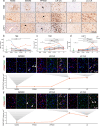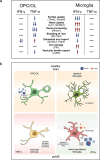Inflammation alters myeloid cell and oligodendroglial iron-handling in multiple sclerosis
- PMID: 40468400
- PMCID: PMC12135419
- DOI: 10.1186/s40478-025-02020-0
Inflammation alters myeloid cell and oligodendroglial iron-handling in multiple sclerosis
Abstract
Changes in brain iron levels are a consistent feature of multiple sclerosis (MS) over its disease course. They encompass iron loss in oligodendrocytes in myelinated brain regions and iron accumulation in myeloid cells at so-called paramagnetic rims of chronic active lesions. Here, we explore the mechanisms behind this overall shift of iron from oligodendrocytes (OLs) to myeloid cells (MCs) and the loss of total brain-iron in MS. We investigated the expression of various iron importers and exporters, applying immunohistochemistry to a sample of control and MS autopsy cases. Additionally, we studied the transcriptional response of iron-related genes in primary rodent OL progenitor cells (OPCs) and microglia (MG) to various combinations of known MS-relevant pro-inflammatory stimuli together with iron loading. Histologically, we identified a correlation of OL-iron accumulation and the expression of the ferritin receptor TIM1 in myelinated white matter and observed an increase in the expression of iron-related proteins in myeloid cells at the lesion rims of MS plaques. qPCR revealed a marked increase of the heme scavenging and degradation machinery of MG under IFN-γ exposure, while OPCs changed to a more iron-inert phenotype with apparent decreased iron handling capabilities under MS-like inflammatory stimulation. Collectively, our data suggest that OL iron loss in MS is mainly due to a decrease in ferritin iron import. Iron accumulation in MCs at rims of chronic active lesions is in part driven by up-regulation of heme import and metabolism, while these cells also actively export ferritin.
Keywords: Iron loss; Iron rim lesions; Microglia; Multiple sclerosis; Oligodendrocytes.
© 2025. The Author(s).
Conflict of interest statement
Declarations. Ethical approval: All studies on post-mortem human samples were performed in accordance with the Ethics Committee of the Medical University of Vienna (EC-vote: 1067/2024 and 1636/2019). Studies on primary rodent cell cultures were performed in accordance with the 2010/63/EU directive. As all procedures were performed post-sacrifice, no review board approval was needed. Animals were primarily sacrificed for diagnostics assays. Competing interests: The authors declare no competing interests.
Figures





Similar articles
-
The relation between BTK expression and iron accumulation of myeloid cells in multiple sclerosis.Brain Pathol. 2024 Sep;34(5):e13240. doi: 10.1111/bpa.13240. Epub 2024 Jan 22. Brain Pathol. 2024. PMID: 38254312 Free PMC article.
-
Spatial mapping of the AA-PGE2-EP axis in multiple sclerosis lesions.Acta Neuropathol. 2025 Apr 29;149(1):39. doi: 10.1007/s00401-025-02878-3. Acta Neuropathol. 2025. PMID: 40299057 Free PMC article.
-
Siponimod for multiple sclerosis.Cochrane Database Syst Rev. 2021 Nov 16;11(11):CD013647. doi: 10.1002/14651858.CD013647.pub2. Cochrane Database Syst Rev. 2021. PMID: 34783010 Free PMC article.
-
Integrative transcriptomic analysis reveals oligodendrocyte lineage switching in multiple sclerosis.Life Sci Alliance. 2025 Aug 4;8(10):e202403150. doi: 10.26508/lsa.202403150. Print 2025 Oct. Life Sci Alliance. 2025. PMID: 40759533 Free PMC article.
-
Teriflunomide for multiple sclerosis.Cochrane Database Syst Rev. 2016 Mar 22;3(3):CD009882. doi: 10.1002/14651858.CD009882.pub3. Cochrane Database Syst Rev. 2016. PMID: 27003123 Free PMC article.
References
-
- Calabrese M et al (2024) Determinants and biomarkers of progression independent of relapses in multiple sclerosis. Annals of Neurology - PubMed
Publication types
MeSH terms
Substances
Grants and funding
LinkOut - more resources
Full Text Sources
Medical

